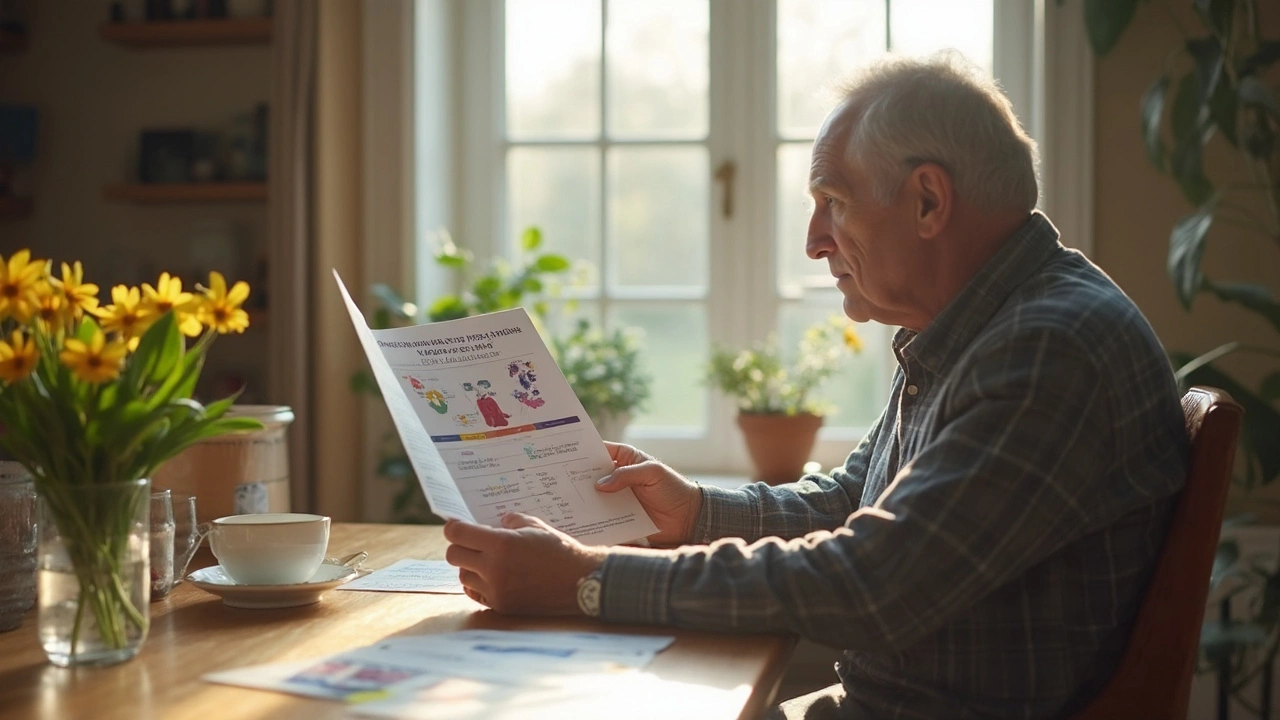
Why Warfarin Was King—And Why People Want Out
Warfarin’s been around since the 1950s, which sounds cool until you realize that’s before microwaves became a thing. People have depended on it to cut the risk of stroke if they have atrial fibrillation, deep vein thrombosis (DVT), or a mechanical heart valve. The stuff does work—it stops clots like magic. But living with it? That’s another story.
If you or a family member’s taken warfarin, you know the drill: constant blood tests. Adjusting your dose because you had a spinach salad. Worrying about every bruise or nosebleed. The level of Vitamin K from foods can throw your INR (a measure of how long your blood takes to clot) out of whack. Going too high means a risk of bleeding, too low can put you back at risk of a clot. That’s a tightrope.
One unsettling stat: Up to 15% of folks on warfarin wind up with some kind of major bleeding if they’re on it more than a year. That’s not just a paper cut—think GI bleeds, nosebleeds that land you in the ER, or even bleeding in the brain. The reason is warfarin’s mechanism: it blocks Vitamin K. Your liver needs Vitamin K to make clotting factors. Warfarin messes with that process across the board—no fine-tuning, just a slap on the system.
This is why people started begging for something newer and, frankly, safer. No one likes to live with that much uncertainty around their blood being too thin or not thin enough. Enter the new wave: direct oral anticoagulants. Or, as you’ll often hear, DOACs.
The Rise of DOACs: Hope (and Hype) for Safer Anticoagulants
Doctors call the new anticoagulants DOACs or NOACs, but they’ve become so common now that most just use their names: apixaban (Eliquis), rivaroxaban (Xarelto), dabigatran (Pradaxa), and edoxaban (Savaysa). These meds work directly on part of the clotting process—usually thrombin or factor Xa. They aren’t vitamin K-based, so the whole food issue disappears, and hardly anyone needs as much blood testing. Sounds like a dream, right?
But the key question: are they safer? How do bleeding risks shake out? A chunk of the answer comes from direct comparisons. In the ARISTOTLE trial, one of the bigger studies, folks on apixaban had a 31% lower risk of major bleeding compared with warfarin. That means for every 100 people treated, about two or three fewer had a big bleed each year. Rivaroxaban was similar—though some trials saw slightly higher bleeding in the gut, it still had a lower rate of bleeding in the brain (arguably the scariest place to bleed).
Why do these new drugs bleed less? It’s about where they act in the process. Warfarin shuts down several steps; DOACs target just one, which seems to allow your body’s emergency-stop system (like platelet plug formation) to pitch in. Less chaos.
No drug is perfect, of course. DOACs can’t be used in folks with bad kidney disease, certain liver problems, or mechanical heart valves (yet). But for typical atrial fibrillation or DVT, the research keeps tipping the scales in favor of DOACs for fewer intracranial bleeds, less hassle, and more stable blood-thinning action. If you’re curious about real-world bleeding rates, the difference is about 1% less major bleeding per year—small, but when it’s your life, it matters.
Dosing is easier, sure, but you still need to take them consistently. Missing a dose can bring your clot risk right back up, and these drugs don’t hang around the body as long as warfarin does. So, set reminders, use apps, do what you need to keep on track. My dog Tully only needs to be told twice to remember dinner, but with blood thinners, once is enough, every single time.

Bleeding Risks: Stats, Reversal Agents, and Real-World Tips
With any blood thinner, bleeding is the shadow that follows you. Here’s what makes a difference. First, the numbers. Bleeding risk depends on who you are and why you need an anticoagulant, but some things cut across the board. For warfarin, major bleeding hits up to 3% of users each year. With DOACs, it’s closer to 2%, and for life-threatening head bleeds, that gap gets even wider in favor of the new agents.
What about accidental overdosing? With DOACs, you’re less likely to blow past the safe zone—but when things go wrong, what can you do? Warfarin’s big advantage used to be that Vitamin K could reverse its effects. If you showed up in the ER, doctors would pump you full of Vitamin K, maybe plasma, and watch your levels drop. For years, the lack of a clear antidote for DOACs gave people pause—but that’s no longer true. Dabigatran, for example, has idarucizumab (Praxbind), and apixaban and rivaroxaban now have andexanet alfa (Andexxa). These reversal agents work fast, with studies showing over 90% effectiveness at getting bleeding under control in emergencies.
Here’s something many people miss: the actual danger with bleeding isn’t just the medicine; it’s what else is going on. Are you on aspirin, ibuprofen, or drinking daily? Do you have untreated high blood pressure? That stuff piles on risk. Pro tip? Tell your doctor about every supplement, every vitamin. Even cranberry juice has thrown off a few patients’ warfarin levels, and some high-dose omega-3s can bump up bleeding with DOACs. Look out for unexpected symptoms: frequent nosebleeds, bloody urine, black stool, or sudden bruises you can’t explain—all should trigger a call to your provider.
Want to see how these numbers stack up? Check out this quick stats table:
| Drug | Major Bleeding (%) | Intracranial Hemorrhage (%) | Reversal Agent Available? |
|---|---|---|---|
| Warfarin | 2-3 | 0.7 | Yes (Vitamin K, plasma) |
| Apixaban | 1.8 | 0.3 | Yes (Andexxa) |
| Rivaroxaban | 2.1 | 0.4 | Yes (Andexxa) |
| Dabigatran | 2.0 | 0.3 | Yes (Praxbind) |
Managing risk at home? Get to know your bleeding profile—the HAS-BLED score is a simple tool doctors use (look it up or ask them). Small changes help: avoid mixing blood thinners, skip the rough contact sports, use a soft toothbrush, and try an electric shaver to dodge accidents. If something seems off, don’t wait. Even a dog like Tully knows when to alert me if someone’s at the door—trust your gut with your body, too.
How to Pick the Right Blood Thinner (and What to Ask)
Here’s the fun part: there’s no one-size-fits-all answer. If you’re reading this, you’re probably hoping for that slam-dunk option. Truth is, it’s about balancing your personal history, risk factors, other meds, and even your habits. Have serious kidney issues? Warfarin may still be your best bet. Want fewer tests, less diet stress, and a safer bleeding profile? DOACs often come out on top.
One wild fact: after the big trials, doctors saw thousands of real-world patients just like you swap warfarin for apixaban or rivaroxaban and do just fine, especially those over 75 or with a wobbly memory—less risk of bad bleeds, fewer ER runs. There are always exceptions, but fewer finger pricks and food restrictions have made life way more livable for most people.
If you’re picking a blood thinner, here are smart conversation starters for your next appointment:
- Ask about your overall bleeding risk—your age, past bleeds, kidney function, and what else you’re taking all matter.
- Find out what reversal agents are on-hand at your hospital and if there’s easy access to them.
- If you play sports or have a high fall risk (I can’t count how many times I’ve tripped with Tully running underfoot), discuss what to watch for and what safety measures you can take.
- Check if any of your habits—herbal supplements, over-the-counter painkillers, or even drinking—could mess with whichever drug you choose.
A regulated routine helps. Set meds next to your toothbrush. Use a smartphone alarm. Share your med list with every doc you see, because drug interactions sneak up on you. And tell your loved ones what you’re on, so if there’s ever an emergency, they can advocate for you quickly.
One more useful tip: Some insurance plans treat newer drugs differently than warfarin, so double-check costs up front. For those navigating the complex world of alternative to warfarin, a breakdown of options can help you speak your doctor’s language—and might save you money, too. Stay curious and persistent; medicine changes fast, and being informed is still your best safety net. Not every new drug is right for everyone, but having the real numbers, stats, and pros and cons in your back pocket can make a difference.
There isn’t one perfect blood thinner. But for most people worried about bleeding and hating the hassle, the new options deliver a less stressful life. DOACs might not cook dinner or take the dog for a walk, but they sure can make managing your risk a little less complicated.
8 Comments
Write a comment
More Articles

The Role of Diet in Preventing and Managing Cystitis
As a blogger, I cannot stress enough the importance of diet in preventing and managing cystitis. A balanced and healthy diet, rich in fresh fruits, vegetables, and whole grains, can help boost our immune system and prevent urinary tract infections. Drinking plenty of water and avoiding caffeine, alcohol, and spicy foods are crucial in managing cystitis symptoms. Including natural supplements like cranberry and D-mannose can also be helpful in preventing recurrent infections. Overall, our diet plays a significant role in maintaining a healthy urinary system and preventing cystitis.

Swollen Glands: Recognizing When to Seek Medical Attention
Swollen glands can be a worrying symptom and understanding when to seek medical attention is essential. This article explains the causes, symptoms, and when to be concerned about swollen glands. It provides practical tips and fresh insights into managing this common health issue. Reading this will help distinguish between minor and serious cases.


Nishigandha Kanurkar
May 1, 2025 AT 06:09THE PHARMA COMPANIES ARE LYING TO YOU!!! DOACs are just a cover-up for the real agenda-Big Pharma wants you dependent on expensive pills that can’t be reversed easily... until THEY control the reversal agents too! Andexxa? Praxbind? Those are just Trojan horses! They’re tracking your INR through your phone app, and if you miss a dose, they trigger a silent alarm to your insurance company! $$$!!!